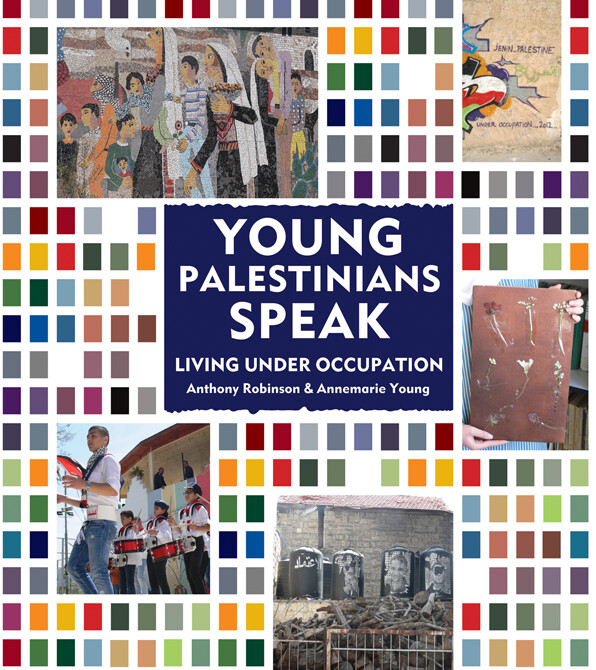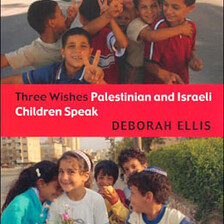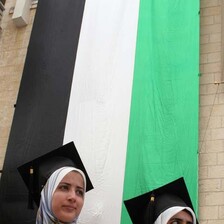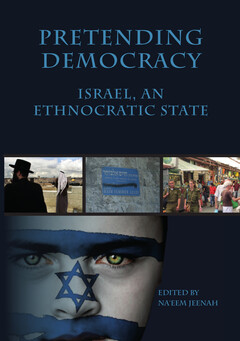The Electronic Intifada 28 August 2017

Young Palestinians Speak: Living Under Occupation by Anthony Robinson and Annemarie Young, Interlink Books (2017)
This book is a labor of love about young people who are born in the perpetual insecurity of a conflict zone. What does it mean to live under military occupation, when soldiers raid your home in the middle of the night and drag your brother or father to jail?
Words have limited power to accurately describe the fear that grips a child when soldiers come to detain him or her. Media accounts of the Israeli occupation, illegal Jewish settlements, checkpoints and Israel’s wall in the West Bank fail to give the reader a feel for what these words really mean or what they may entail for people in their daily life.
Palestinians as regular human beings are largely absent from mainstream media; they usually simply appear as statistics, or are portrayed as anti-Israeli or as terrorists.
Young Palestinians Speak is an attempt to correct this injustice.
It offers young readers a glimpse of what their Palestinian peers think, how they feel and what they aspire to do in their lives. The reader learns that Rand wants to become a fashion designer, Shabeh wants to be a doctor, Basel wants to become an architect, while Tarteer and Abran want to become school teachers.
The authors, both longtime children’s book writers, situate the interviews through a brief historical introduction, a description of what the Israeli occupation is about and a list of key terms and issues such as settlements, water – or the lack of it – and access to education. The language, devoid of jargon, is easy to read and understand.
Life for young Palestinians living under military occupation has been difficult even under the best of circumstances. What is remarkable is that nearly every one of the interviewees either knows someone or is related to a person in an Israeli jail. They all report frightening encounters with Israeli soldiers that occur almost daily.
The Palestinian rights group Addameer reports that as of July, Israeli authorities were holding a total of 320 Palestinian minors.
A level of normalcy
The interviews with young Palestinians were arranged by Tamer, a community educational organization with headquarters in the occupied West Bank city Ramallah.
That the children are able to achieve some level of normalcy in difficult circumstances is a fantastic accomplishment. Yasmeen from Jenin, for example, says that a normal day for her consists of “school, reading, watching TV and listening to music … and I write poetry and stories sometimes.”
The interviews with youth in Gaza reflect the acute crisis there. Following the Israeli offensive on Gaza in late 2012, a Tamer coordinator describes the following:
After an attack, the kids don’t talk about their dreams or hopes. They just can’t or won’t. They are nervous and angry … boys also find it hard to focus. They tend to be overactive and violent. Girls suffer from feelings of isolation and aloneness.
The interviews in occupied East Jerusalem sound similar to those in other parts of the West Bank and the Gaza Strip. They, however, do not reflect the unique urgency of the city where Palestinians are increasingly – and methodically – being driven out. This may be the book’s only shortcoming.
Sad yet hopeful
At the end of the book is a timeline of the Israeli occupation as well as recommendations for further information, including films, websites, human rights organizations and other, related books for young people.
The photography throughout helps illustrate the children’s testimonies. One photo shows the striking effect of Israel’s wall in the West Bank that cuts through the Palestinian village of Beit Ur al-Tahta. The picture is of a storm drain under Highway 443, practically the only way for the children to get to school.
Another powerful photograph is of the beautiful village of Sebastiya, near Nablus in the northern West Bank. Ahmed, a local farmer interviewed for the book, says that the historic ruins go back 10,000 years and span six cultures, including Canaanite, Israelite, Hellenistic, Herodian, Roman and Byzantine.
Once a thriving tourist destination, the village is now impoverished due to the Israeli checkpoints and other movement restrictions, making it more difficult to reach.
Another photo depicts drawings of palm trees and houses by children between 8 and 12 years old. This is obviously not their reality but what they dream of. These same children say they live in a “prison, controlled by Israel on land, from the sea and the sky.”
This is a unique book showcasing the voices of young Palestinians who look and sound like other children throughout the world. They live in difficult conditions but nevertheless attempt to lead normal lives and dare to dream of a better future.
Fouad Moughrabi is an emeritus professor in the department of political science, University of Tennessee at Chattanooga, and founder/director of the Qattan Center for Educational Research and Development, Ramallah (1999-2005).





Comments
Books like this should be
Permalink Steve replied on
Books like this should be translated in many languages so people know through what pain some have to pass. Sadens me